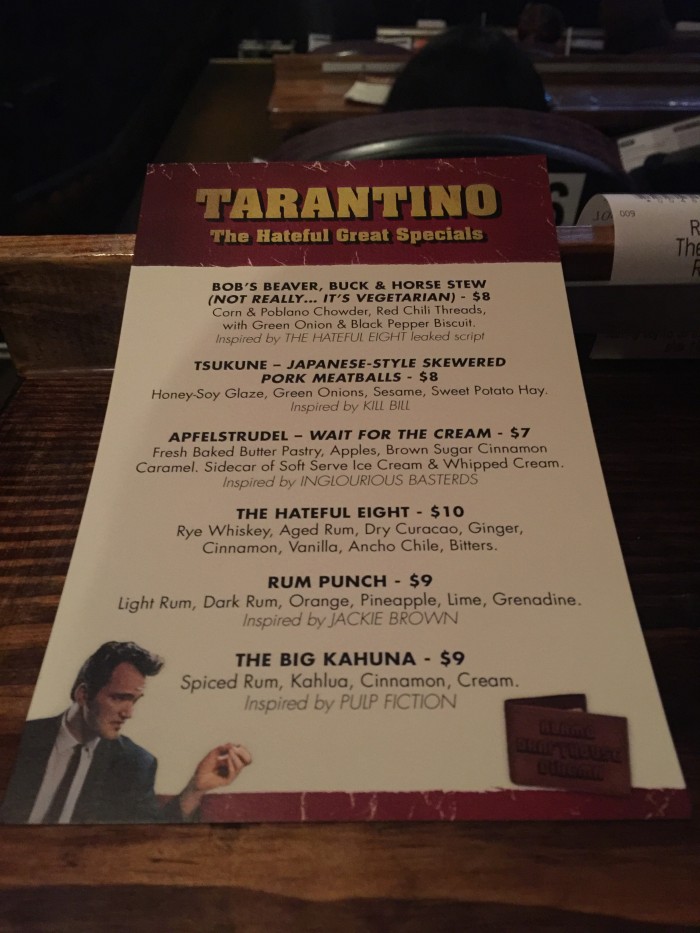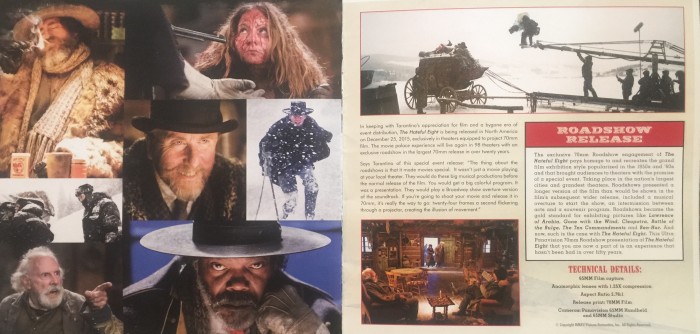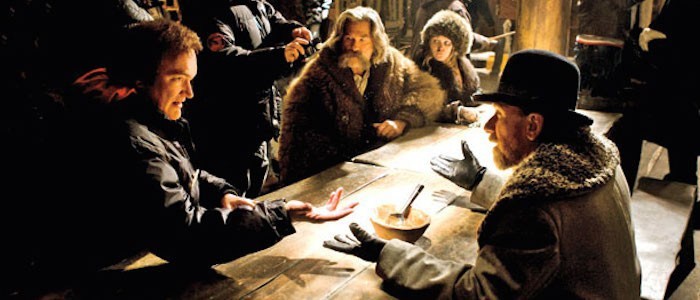'The Hateful Eight' Roadshow Report: How Does Quentin Tarantino's Latest Play In Glorious 70mm?
Quentin Tarantino's The Hateful Eight opened on 100 screens this past week as part of a unique, limited engagement. These 100 theaters would not be screening the movie through digital projection, but on 70mm film, a format that is all but extinct. That alone is an ordeal and a half, but that unique projection would only be one aspect of this "roadshow" release. There would also be an overture. And an intermission. And souvenir programs. Tarantino's obsession with classic film presentation has climaxed – to watch The Hateful Eight in this format is to take a three-hour journey back in time, to an age where movies were truly sold as proper events.
As a sucker for Tarantino's work (I did rank all 122 of his characters) and an even bigger sucker for unique, one-of-a-kind theatrical experiences, I knew there was no way I was going to miss seeing The Hateful Eight in "glorious" 70mm. So, here's how it all went down.
The Theater
Although there are several theaters screening The Hateful Eight in its roadshow version in Austin, Texas, certain nightmare stories from around the country made me very picky about where I would see the movie. Since many multiplexes haven't utilized film projectors in years, tales of mistakes and mishaps swept the internet in wildfire. Broken projectors. Melted prints. Theater managers simply throwing their hands in the air and screening DCPs instead.
My decision made itself: I would see the film at the Alamo Drafthouse Ritz in downtown Austin. First of all, the Drafthouse's famously strict no-talking policies would ensure a solid audience. Second of all, the Ritz location was already equipped with a 70mm projector and had a staff that knew what they were doing in the booth. In addition to various repertory screenings, I had previously seen The Master, Interstellar, and Inherent Vice projected in 70mm here and the projection had never been anything short of flawless. If you live near a theater with repertory experience, it may be a better choice than the theater at your local mall – the chances of a professional projectionist being involved (and not a hapless, underpaid teen) are probably little higher.
Plus, the Drafthouse had devised its own special Tarantino-themed menu:
If you want to check out this version of The Hateful Eight (and, spoiler alert, you do), check this Reddit thread before you commit to a long drive. It's a fairly comprehensive look at which theaters are providing a great show and which ones are s***ting the bed.
The Program
Despite tickets priced at a premium and the constant internet chatter about the exclusivity of this whole endeavor, The Hateful Eight didn't start to feel like a proper event until I received my souvenir program. Here's the thing: this program is nothing fancy. It's only about ten pages and most of those pages are dedicated to stills from the film and photos from the set. It's not the kind of thing that lights your world on fire, and serious collectors of movie merchandise won't be bowled over by it.
But you know what? A for effort, and I mean that with approximately zero condescension. Getting to flip through this booklet while waiting in the lobby and then while waiting in the theater enhanced the experience in a low-key but significant way. This little book made the movie feel like Something Special instead of just another late-night screening. In the age of the internet, this felt like the old-school hype machine that powered epics like Gone With the Wind coming back to life. If the job of a souvenir program is get you invested in a movie before a single frame is screened, then this thing did its job.
The Audience
I saw The Hateful Eight at 10:50 at night on a Monday and the theater was still completely sold out. I know I can chalk a certain amount of this up to living in a cinephile-friendly town full of movie fans who don't care about little things like "work in the morning," but the energy in the lobby before the theater started seating was electric. People were excited to be here. People were excited to be watching a movie in this format. The Ritz's small lobby was jam-packed – you couldn't walk a single step without bumping into someone else. I've seen screenings this busy before, but never this late on a Monday night.
The energy of the lobby carried into the theater. The Hateful Eight is a lot of things, but it is, above everything else, a crowd movie. Whether that crowd is laughing at its pitch-black comedy, cheering on its merciless cast of vicious characters, or cringing at the third act's brutal and bloody violence, this is a film that all but demands an audible reaction every few minutes or so. During the (hugely necessary and well-timed) intermission, you could feel the mixed reactions brewing in the air. For every filmgoer who was giddy to get back to their seat for the final stretch, there was someone else who was more wary about what lay in store. Although a 15-minute break in the middle of a three-hour movie allows for a fantastic physical break, the real pleasure came from having a chance to pause, think about what you've already seen, discuss your feelings with your neighbors, and mentally prepare for what comes next. Stretching has nothing on having the chance to reflect on what you've seen mid-movie.
The Projection
I've seen enough movies projected in 70mm to know that this is my absolute favorite way to watch a movie. I also know that I've been spoiled, and that for many moviegoers (especially younger ones), this may be their first chance to experience this sadly antiquated format. That's why the news of so many screenings going terribly wrong was such a huge bummer – when someone who actually cares about what they're doing is manning the projector, 70mm is downright magical.
Thankfully, the Ritz did not disappoint. Our projection was flawless and a testament to the power of film and the trained professionals who know how to give film its due in a movie theater.
I've grown so used to watching digitally projected films on a daily basis film still has the power to knock me on my ass. From the film's opening shots, Tarantino and cinematographer Robert Richardson take full advantage of their film stock and those old, impossibly wide lenses they dug out of Panavision's vaults. The outdoor sequences serve as a reminder why this was the format of choice for Hollywood's biggest epics. You haven't seen color and detail until you've seen 70mm projected properly on a big screen.
However, The Hateful Eight eventually moves indoors for the bulk of its running time, and that's where the 70mm presentation gets really interesting. Sweeping vistas and gorgeous landscapes are natural subjects for this format, but a violent, intimate, racially charged thriller about a group of bad people trapped in a building that's way too small really takes on a special kind of life through this lens. The claustrophobic set takes on a life of its own. Every close-up takes on an unforeseen importance. You become aware that you're watching the results of a chemical process instead of a bunch of pixels. The fine and ever-shifting layer of grain over every image makes the movie feel downright alive. The handful of scratches (which is inevitable with any film print) only remind you that you are watching a physical object, not a digital file. The Hateful Eight is a raw, personal movie. It demands a raw, personal format.
The Film
Okay, but enough about the technical presentation and the audience and the theater and the special menu and the free souvenir program. How was the movie?
The Hateful Eight is very, very, very good. Maybe even great. Even while watching it, I could tell that the film was going to require a second viewing. This is, after all, a movie about eight strangers who spend 187 minutes lying through their teeth – once we know what's true and false, we can luxuriate in the strong performances and the menacing tone without trying to keep up with the action.
Menacing is probably the best word to describe The Hateful Eight. From opening credits, where Ennio Morricone's unsettling score hints at the dread to come, to the grand finale, complete with all of the trademark viciousness you've come to expect from Tarantino, this is a film that refuses to treat the audience with kindness or even give them someone to relate to. Every single character in this movie is a bad person and all of them suffer and none of them learn anything. The Hateful Eight is, above all else, an exercise in tension. What happens when a group of hateful, despicable people find reasons to draw their guns while stranded in the middle of the blizzard? The fact that this is a movie about an ensemble of not-nice people distrusting each other in a single location invites Reservoir Dogs comparisons, but The Hateful Eight is more like a feature-length version of that the bar scene in Inglourious Basterds. Even when the guns are holstered, you know that no one is telling the complete truth. Tension is derived from waiting for the lie that will finally topple everything.
While The Hateful Eight functions as a taut and grotesque mystery (it would feel like Agatha Christie if not for the fact that the film features an exploding head or two), its nastiness feels all too close to home. It's no accident that Samuel L. Jackson plays the sole black man stranded in a room inhabited by white men (and one woman) in post-Civil War Wyoming. It's certainly no accident that Walton Goggins plays a former Confederate war criminal who has just accepted a job as a lawman. Racial tension drives much of the action in The Hateful Eight, but it's just the doorway. This is a movie about hate of all kinds and how the deep divides that continue to wound America today are nothing new. This is a movie about humanity's dirty secrets, the rotten core that lurks under the visage of civilization. Above all else, we are powered and empowered by our hate.
The Overall Experience
The Hateful Eight is probably too long. During our walk back to the car following the screening, my wife described wanting to take a juicer to the first half and I can't help but agree. This is Tarantino at his most indulgent.
Then again, this whole roadshow experience is nothing but pure indulgence. The Hateful Eight didn't have to be released like this. It could have been dumped into theaters via DCP and The Weinstein Company could have saved themselves a lot of time and a lot of trouble. A significant portion of moviegoers wouldn't have cared and would have seen it anyway.
But I'm thankful for this indulgence. Tarantino may be indulging his film fetishistic whims with this endeavor, but he's also indulging film fans all over the world. The Hateful Eight roadshow feels like modern master reaffirming a great truth: movies matter and how we watch movies matter. The next time you go to a theater and endure lousy projection, tinny sound, texting audience members, and management that doesn't care about providing you with a memorable time at the movies, remember that you have a powerful ally in your despair over the state of modern film presentation. You don't have to like Tarantino and you don't have to like The Hateful Eight to recognize that this is something very cool and very special. Digital projection is here to stay and that's okay. It's fine. But 70mm roadshows complete with souvenir programs and an intermission? That's an indulgence I can get behind.
I know that not every theater will perform up to this level. I know that not every audience will be as great as mine. But if you are going to see The Hateful Eight (and it gets a hearty recommendation from yours truly), this is the way to go.
Did you see the roadshow? Was it a memorable experience for you? What went right? What went wrong? Please share your stories in the comments below.



